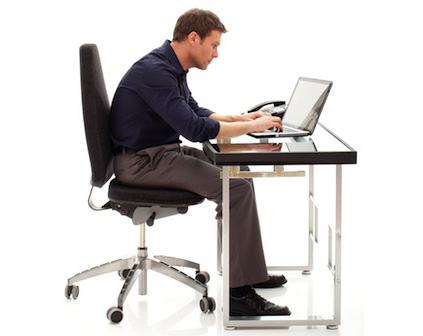The dangers of sitting down all day in the office

Sleeping, driving to work, sitting at a desk, driving home, watching TV, sleeping: a typical day for many office workers. But what do all these activities have in common? They are all done sitting or lying down. In an age when we rely increasingly on technology to get the job done, it can be difficult to avoid the dangers of sedentary living. However, studies have shown that sitting all day can not only damage our musculoskeletal system but is also linked to a range of other health problems, such as obesity, heart disease and diabetes.
The dangers of sedentary living
Studies have linked excess sitting with being overweight, high blood pressure and obesity which can increase your risk of being affected by diabetes and cardiovascular disease. Leading experts are now suggesting that, although regular exercise is good for you, it cannot completely counteract the effects of sitting for too long.
Those aches in your wrist or neck and pain in your shoulders or lower back that you may not think anything of could have been caused by sitting incorrectly at your desk for long periods of time. Being hunched over your desk or slouching in your chair can put unnecessary stress on your spine which can cause it to change position. Such misalignment can cause unnecessary strain on the surrounding muscles and tissues in your back.
So know you are aware of the dangers of a sedentary lifestyle … what can you do to combat the effects of sitting down all day? Here are a few simple suggestions that you can incorporate easily into your daily working routine:
Walk to and from work (if possible)
Most of us are guilty of hopping in our car to undertake a short journey that could otherwise have been done on foot. If you live close to your workplace, why not ditch the car and walk to work instead? Not only are you moving around more but you are also cutting emissions and saving the planet at the same time!
Stand whilst you are on the phone or in meetings
Official recommendations from the Department of Health suggest taking a break from sitting down every 30 minutes. Make meetings more exciting by standing up or stand up whilst taking a long phone call.
Walk to a colleagues desk to speak to them instead of sending an email
They will thank you for not clogging up their inbox and you may even make new friends!
Use your lunch break wisely
It is tempting when you are busy at work to have a quick lunch sat at your desk, but this quickly adds to your daily time spent seated. Even if it is only 10 to 15 minutes, use your lunch break to have a quick stroll and give your eyes a break from staring at a screen.
What can we do to help you combat the effects of sitting down for too long?
At Physio Leeds, we understand that sitting at a computer is a necessary part of many office jobs. This is why we have been visiting companies in Yorkshire to carry out workstation risk assessments and
Display Screen Equipment (DSE) assessments for over ten years. We have helped companies such as The UK Border Agency, BBC and the DVLA to ensure their employees are sitting comfortably at their desks and that they, as an employer, are sitting comfortably within the law. It is a legal requirement that DSE assessments must be conducted for all significant users of display screen equipment.
During our individual DSE assessments, our trained physiotherapists visit employees at their workstations to assess their equipment, seating and posture and make suggestions on changes that can be made to minimise the risk of musculoskeletal damage. You will be surprised about how little changes, such as the positioning of your keyboard or the height of your chair, can make a huge difference to your health. We make on the spot changes as well as providing a detailed report of our findings and support in planning daily exercise routines that can be done whilst working.
Get in touch today to book your individual DSE Assessment.
References i NHS UK, Why sitting too much is bad for your health (2014) ii Department of Health, Sedentary Behaviour and Obesity: Review of the Current Scientific Evidence (2010)
